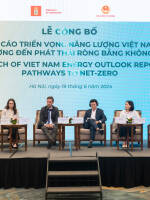
What are your perspectives on Vietnam’s carbon credit market recently?
Carbon credits are used to buy, sell, exchange and transfer the outcomes of reducing greenhouse gas emissions generated from activities that reduce greenhouse gas emissions and remove (absorb carbon) among individuals, organizations and countries. One carbon credit is equal to a ton of CO2 (carbon dioxide) equivalent. CO2 equivalent tonnage is the mass of greenhouse gases converted into tons of CO2 according to the global warming coefficient of those greenhouse gases. The global warming coefficient of greenhouse gases is determined by the Intergovernmental Panel on Climate Change.
In over 200 latest years, experiencing three past industrial revolutions and the fourth ongoing revolution, the world has changed faster than the previous period thousands of years and humanity has made numerous breakthrough economic and social achievements. However, we are also paying the price for this development when climate change becomes a global environmental challenge, that is to say, a sharp increase in temperature, rapid ice melting at the earth poles that result in rising sea levels, and extreme weather events that cause severe but frequent natural disasters that seriously damage affecting the life and future of humanity. In Vietnam, per capita greenhouse gas emissions have increased fourfold this century and are growing fastest in the world.
Vietnam has responded strongly to that risk and adopted sustainable development (ESG = Environment, Society and Governance) through a strong commitment to make the best effort to achieve the Net Zero Carbon goal by 2050 as stated by Prime Minister Pham Minh Chinh at the 26th Conference of the Parties to the United Nations Framework Convention on Climate Change (COP26).
Fulfilling this commitment is truly challenging to all countries, especially developing countries like Vietnam, due to many limitations in financial, technological and administrative capacity. Although the Government has made great efforts to introduce many policies to encourage and promote sustainable, environmentally friendly, low-carbon production development, the results obtained are now still modest and the actual progress is currently slower than the given roadmap.
Vietnam has relatively high forest coverage, currently at 42%, or equivalent to about 14.7 million hectares. Furthermore, forestry is the only sector that is generating negative emissions, with an estimated average annual net emissions of negative 39 million tons of CO2 equivalent between 2010 and 2020. This is a potential investment area for planting new forests, enriching natural forests, improving planted forest productivity, and fostering sustainable forest management to create carbon credits. These solutions are suitable for Vietnam’s socioeconomic conditions, especially when implementing mitigation measures to achieve the net zero carbon emissions as pledged. Carbon credit sources can help us be self-reliant and balance the amount of carbon emissions generated during production and living processes. In fact, in recent years, planting new forests, enriching forests and improving the productivity and quality of planted forests has produced some positive outcomes.
Specifically, in 2020, Vietnam and the Forestry Carbon Partnership Fund (FCPF) signed an agreement to pay US$51.5 million to reduce greenhouse gas emissions in the North Central region in 2018 – 2024, covering Thanh Hoa, Nghe An, Ha Tinh, Quang Binh, Quang Tri and Thua Thien – Hue provinces. Indeed, other regions in the North, the Central Highlands and the South also have great potential in this field. The Government issued Decree No. 107/2022/ND-CP on implementation of this agreement and introduced benefit sharing plan for beneficiaries. The Government has continued to improve institutions and legal frameworks to promote the formation of carbon markets in Vietnam, especially voluntary carbon markets, to facilitate domestic and foreign businesses and investors interested forest carbon credit trading.
On the demand side, Vietnam has continued to be a safe and effective investment destination for the business community around the world. With the recent rapid increase in FDI inflows, businesses product outputs are forecast to grow sharply, including a large volume of goods exported to demanding markets such as the EU, the US and Japan which are currently imposing strict requirements for controlling and reducing carbon emissions in production and distribution. This is a large consumer of generated carbon credits.

How is the logistics industry in general and HPLA in particular approaching this matter?
One of essential elements in the sustainable development strategy and the transition to a green economy is building a green supply chain. Greening the logistics industry and applying green logistics to business will help companies meet environmental criteria and improve competitiveness and sustainable growth.
While developed regions in the world such as the EU and the US or Japan in the near term are applying carbon tax barriers to imported and exported goods, Vietnam needs to be more active in building and developing the carbon market. This is a challenge but also an opportunity for companies to transform, research and apply green solutions, reduce emissions, and take measures to create and accumulate carbon credits.
Logistics, at its core, is all types of transportation, most of which use emission-intensive fossil materials (such as gasoline, oil and gas). Meanwhile, most companies are small and medium in size, with limited capabilities, and cannot shift from vehicles running on fossil fuels to green, eco-friendly ones. The active preparation to create carbon credit sources has been cared and promoted by HPLA with many solutions. HPLA has coordinated with localities to create forest-based credit sources, including planting new forests, enriching forests, and improving productivity of planted forests. And this amount of created carbon credits will help HPLA member companies to balance themselves with emissions from vehicles, ports and warehouses, while creating a competitive advantage for members.
After piloting in one or two provinces to ensure enough carbon credits for its members, HPLA will continue to expand the scope to create a source of carbon credits for the business community in Hai Phong and the region, helping promote foreign investment, concretizing the “Green Growth” goal of Hai Phong City and the region as well.
How has HPLA specifically done to approach sustainable forest-based credit sources?
In recent years, with the support of international partners, the forestry sector has carried out several forest-based carbon credit exchange projects to mobilize additional financial resources to directly invest in forest management, protection and development. On that basis, forest owners are paid for efforts to reduce greenhouse gas emissions and increase carbon absorption and this payment is based on their outcomes.
On March 29, 2024, HPLA worked with the Bac Kan Provincial People’s Committee on creating a sustainable source of carbon credits from planting new forests and enriching natural forests in the province. Chairman of the Bac Kan Provincial People’s Committee Nguyen Dang Binh said that the total area of forested land in Bac Kan is currently 374,000 ha, of which 271,804.94 ha is natural forests and 102,222.18 ha is planted forests. The province’s forest coverage in 2023 was more than 73% with a thick, stratified vegetation system that can absorb large amounts of carbon dioxide. This is an advantage to develop and trade forest carbon, a product that will bring great revenue to the province in the future.
Bac Kan province is also researching and developing a carbon credit trading project so as to attract investment resources for local forest management, protection and development, thus helping increase income for people who depend on forests and forest preservation. The province strongly supports HPLA in carrying out surveys, statistics and assessments of forest carbon credit potential as well as implementing new forest planting and enrichment with forest owners in the province.
HPLA clearly stated the purpose, finance and time of surveying and preparing a report to assess carbon credit potential in Bac Kan, the significance of sustainable forest development and benefits from selling carbon credits.
To sign a cooperation agreement on creation of forest carbon credits with Bac Kan province, HPLA coordinated with the Vietnam Forest Certification Office (VFCO) and sent survey experts to localities and forest owners in Bac Kan province. Consequently, experts also promoted communications on benefits of developing forest-based carbon credits, especially for ethnic minorities.
According to surveys, currently, in addition to the primary forest area, a majority of forests in Bac Kan province has low carbon reserves, especially production forests with acacia, eucalyptus and other trees. Therefore, it is necessary to enrich these forest areas, apply technical advances, select tree species and adopt appropriate business cycles to create carbon credits. Moreover, attention should be paid to non-timber forest product development and livelihood development to boost socioeconomic development for local communities.
We hope that through communicative and consulting activities for implementation of solutions to forests enrichment and sustainable forest development, people will see values and benefits that are far superior to the way they are doing now. Doing so will help change thinking and method of doing. At the same time, it will help enhance and spread awareness carbon credit development in forest management, protection and development to all levels, sectors and the business community.
Regarding further goals, HPLA wants to participate and strongly spread this activity to localities with high forest potential such as Cao Bang, Thai Nguyen, Yen Bai and Phu Tho for joint sustainable development. To do this, there needs to be drastic participation from the entire political system. Last but not least, in industrially developed provinces and cities, businesses need to be aware of carbon credit creation and must immediately embark on implementation, contributing to the successful achievement of Vietnam’s Net Zero commitments.
Thank you so much!
Ha Thanh – Ngoc Tung




